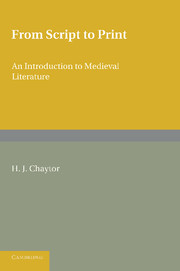Book contents
- Frontmatter
- Dedication
- Contents
- Preface
- Miscellaneous Frontmatter
- Chapter I Introduction
- Chapter II Reading and Writing
- Chapter III Language and Nationality
- Chapter IV Style and Criticism
- Chapter V Prose and Translation
- Chapter VI Publication and Circulation
- Chapter VII Conclusion
- Appendices
- Appendix A
- Appendix B
- Appendix C
- Appendix D
- Index
Appendix C
from Appendices
Published online by Cambridge University Press: 05 June 2016
- Frontmatter
- Dedication
- Contents
- Preface
- Miscellaneous Frontmatter
- Chapter I Introduction
- Chapter II Reading and Writing
- Chapter III Language and Nationality
- Chapter IV Style and Criticism
- Chapter V Prose and Translation
- Chapter VI Publication and Circulation
- Chapter VII Conclusion
- Appendices
- Appendix A
- Appendix B
- Appendix C
- Appendix D
- Index
Summary
Rimes for the eye or visual rimes are due in part to tradition, preserved by the printed language. Pronunciation changes, while orthography remains fixed, and rimes that once were perfect and are now false are allowed by poetic usage to remain, provided that the tradition is supported by identity of spelling; thus Shelley could write:
Lured by the love of the genii that move
In the depths of the purple sea.
A further excuse is found in the fact that English is a language poor in rimes, as compared with many other languages. French is inclined to run to the opposite extreme; rimes acoustically correct are banned, if they are orthographicaUy different: nous—hup, bonti—chantez and the like, though homophonous in modern pronunciation, are regarded as incorrect. This is a tradition from pre-seventeenth-century pronunciation, when final consonants were sounded; but exceptions can be found as early as La Fontaine, and modern poets allow themselves considerable freedom in this respect.
The controversy upon the value of rime as enhancing or hindering poetical effect has been going on since Trissino attacked rime at the outset of the sixteenth century. Most French critics agree with Voltaire, that blank verse in French is a failure, because it is indistinguishable from prose. This assertion probably refers to recited verse; if unrimed alexandrines were printed as prose, the reader would speedily discover the fact; a recitation in a strong 'sing-song' manner might also betray it. But French, being a langue homotone, cannot do without rime, as can languages with a strongly marked stress accent. However, this matter and the relation of rime vowels to the musical scale, on which much has been written, are outside of our subject. A book which summarises previous discussions and adds some new information is The Physical Basis of Rime, H. Lanz (Stanford University Press, 1931); it also contains a useful bibliography.
- Type
- Chapter
- Information
- From Script to PrintAn Introduction to Medieval Literature, pp. 147 - 148Publisher: Cambridge University PressPrint publication year: 2013



